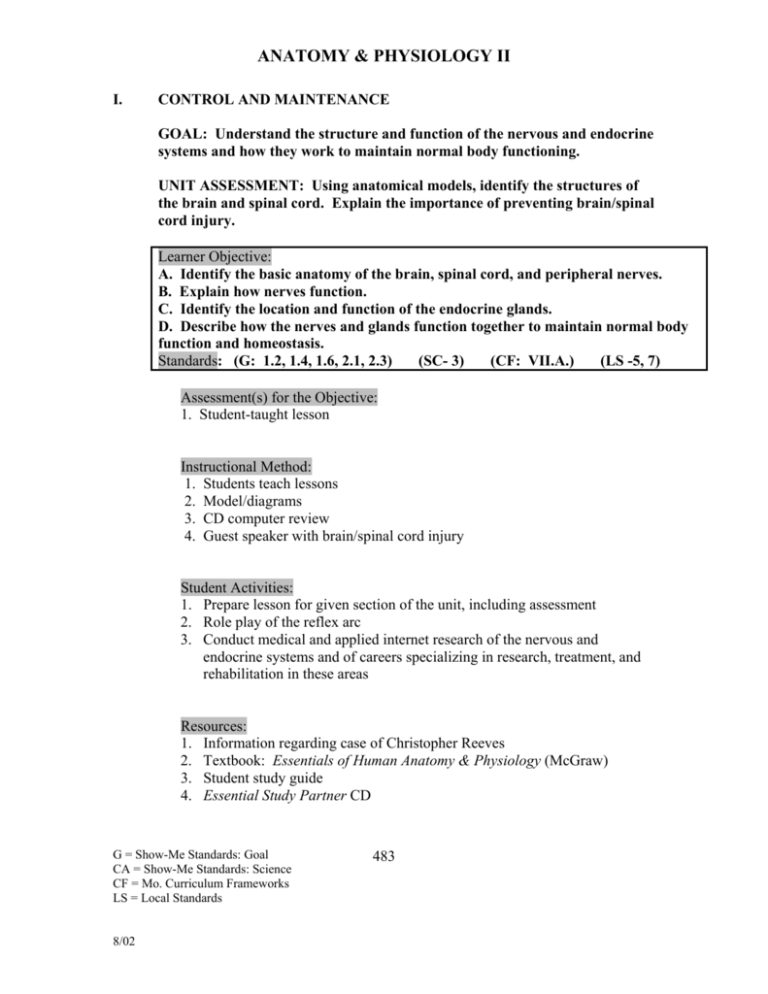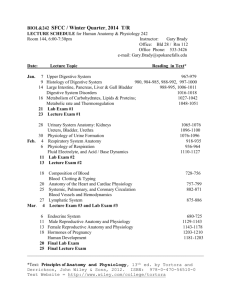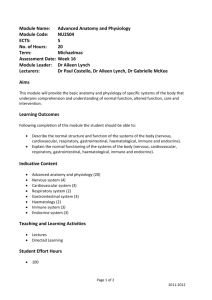ANATOMY & PHYSIOLOGY II
advertisement

ANATOMY & PHYSIOLOGY II I. CONTROL AND MAINTENANCE GOAL: Understand the structure and function of the nervous and endocrine systems and how they work to maintain normal body functioning. UNIT ASSESSMENT: Using anatomical models, identify the structures of the brain and spinal cord. Explain the importance of preventing brain/spinal cord injury. Learner Objective: A. Identify the basic anatomy of the brain, spinal cord, and peripheral nerves. B. Explain how nerves function. C. Identify the location and function of the endocrine glands. D. Describe how the nerves and glands function together to maintain normal body function and homeostasis. Standards: (G: 1.2, 1.4, 1.6, 2.1, 2.3) (SC- 3) (CF: VII.A.) (LS -5, 7) Assessment(s) for the Objective: 1. Student-taught lesson Instructional Method: 1. Students teach lessons 2. Model/diagrams 3. CD computer review 4. Guest speaker with brain/spinal cord injury Student Activities: 1. Prepare lesson for given section of the unit, including assessment 2. Role play of the reflex arc 3. Conduct medical and applied internet research of the nervous and endocrine systems and of careers specializing in research, treatment, and rehabilitation in these areas Resources: 1. Information regarding case of Christopher Reeves 2. Textbook: Essentials of Human Anatomy & Physiology (McGraw) 3. Student study guide 4. Essential Study Partner CD G = Show-Me Standards: Goal CA = Show-Me Standards: Science CF = Mo. Curriculum Frameworks LS = Local Standards 8/02 483 ANATOMY & PHYSIOLOGY II II. CIRCULATION GOAL: Understand the structure of the circulatory system and how it contributes to maintaining normal body functioning. UNIT ASSESSMENT: Using anatomical models, students identify the major structures in the cardiovascular system and discuss how diet, stress, and substance abuse effect the cardiovascular system. Learner Objective: A. Identify the major arteries, veins, and structures of the heart in the circulatory system and the mechanism of blood flow and particle transport through the body. B. Explain the cardiac cycle and how it is controlled. C. Identify the characteristics of a normal EEG pattern. D. Explain how blood pressure is produced and controlled. E. Examine the effects of diet, stress, substance abuse, and various cardiovascular diseases. F. Identify the major structures and functions of the lymphatic system. Standards: (G: 1.4, 1.6) (SC -3) (CF: VII.A.) ( LS -1, 5, 7) Assessment(s) for the Objective: 1. Lab practical quizzes 2. Positive lifestyle program for cardiovascular health Instructional Method: 1. Lecture: Trace the pathway of blood through the body and heart. 2. Lecture: Discuss the significance of normal EEG pattern 3. Models/diagrams 4. Video 5. CD computer review Student Activities: 1. Cardiovascular exercise program 2. Blood pressure/heart rate lab 3. Conduct medical and applied internet research of the circulatory system, including careers specializing in research, treatment, and rehabilitation. 4. Cat dissection Resources: 1. Textbook: Essentials of Human Anatomy & Physiology (McGraw) 2. Student study guide 3. Essential Study Partner CD 4. Student lab manual G = Show-Me Standards: Goal CA = Show-Me Standards: Science CF = Mo. Curriculum Frameworks LS = Local Standards 8/02 484 ANATOMY & PHYSIOLOGY II III. RESPIRATION GOAL: Understand the structure of the respiratory system and how it contributes to maintaining normal body functioning. UNIT ASSESSMENT: Using anatomical models, students label the major structures in the respiratory system. Students explain how substance abuse, disease, and environmental factors affect the respiratory system. Learner Objective: A. Identify the anatomy and physiology of the respiratory system. B. Explain the processes of inspiration and expiration. C. Explain how air and blood exchange gases and how the blood transports these gases. D. Define each of the lung volumes and respiratory capacities. E. Explain the effects of various respiratory diseases, environmental factors, and substance abuse on the respiratory system. Standards: (G: 1.2, 1.4, 1.6, 2.1) (SC -3) (CF: VII.B.) ( LS -1, 5, 7) Assessment(s) for the Objective: 1. Lab Practical quizzes 2. Lung Volume lab Instructional Method: 1. Lecture 2. Models/diagrams 3. Demonstration of the effect of exercise on respiration Student Activities: 1. Lung Volume/Respiratory Capacity lab 2. Conduct medical and applied internet research including careers specializing in research, treatment, and rehabilitation of respiratory system. 3. Discuss healthy lifestyle/environmental influence on lung disease. 4. Cat dissection Resources: 1. Textbook: Essentials of Human Anatomy & Physiology (McGraw) 2. Student study guide 3. Essential Study Partner CD 4. Student lab manual G = Show-Me Standards: Goal CA = Show-Me Standards: Science CF = Mo. Curriculum Frameworks LS = Local Standards 8/02 485 ANATOMY & PHYSIOLOGY II IV. DIGESTION AND NUTRITION GOAL: Understand the structure of the digestive system and how it operates to maintain normal body functioning. UNIT ASSESSMENT: Using anatomical models, students identify the major structures in the digestive system. Students will design a healthy diet to accomplish weight gain, weight loss, and weight maintenance. Learner Objective: A. Identify the major organs of the digestive system and describe general functions. B. Name the enzymes secreted by the digestive organs and describe their functions. C. Describe how digestive secretions are regulated and how the products of digestion are absorbed. D. List the appropriate food sources for carbohydrates, fats, proteins, and the major vitamins and minerals. Standards: (G: 1.10, 2.7) (SC -3) (CF: VII.B.) ( LS -5, 7) Assessment(s) for the Objective: 1. Lab Practical quizzes Instructional Method: 1. Lecture 2. Models/diagrams 3. Mouth enzyme demonstration Student Activities: 1. Taste discrimination lab 2. Design a menu and prepare the meal containing healthy balance of important nutrients. 3. Conduct medical and applied internet research including careers specializing in research, treatment, and rehabilitation of digestive system. 4. Cat dissection Resources: 1. Textbook: Essentials of Human Anatomy & Physiology (McGraw) 2. Student study guide 3. Essential Study Partner CD 4. Student lab manual G = Show-Me Standards: Goal CA = Show-Me Standards: Science CF = Mo. Curriculum Frameworks LS = Local Standards 8/02 486 ANATOMY & PHYSIOLOGY II V. EXCRETION GOAL: Understand the structure of the excretory systems and how it operates to maintain normal body functioning. UNIT ASSESSMENT: Using anatomical models, students identify the major structures in the excretory system. Given a sample urinalysis, students interpret results and identify excretory diseases. Learner Objective: A. Identify and locate the kidneys and list the general functions of the excretory system. B. Explain the method of glomerular filtration, factors that affect filtration, and how filtration is regulated. C. Describe the process and control of urination. Standards: (G: 1.2, 1.4, 1.6, 2.3, 3.5 ) (SC -3) (CF: VII.B.) ( LS -5, 7) Assessment(s) for the Objective: 1. Lab Practical quizzes 2. Urine analysis lab 3. Interpretation of urine analysis and disease Instructional Method: 1. Lecture: Trace the pathway of blood through the kidney. 2. Models/diagrams 3. Video Student Activities: 1. Urine analysis lab 2. Cat dissection 3. Conduct medical and applied internet research including careers specializing in research, treatment, and rehabilitation of excretory system. Resources: 1. Textbook: Essentials of Human Anatomy & Physiology (McGraw) 2. Student study guide 3. Essential Study Partner CD 4. Student lab manual G = Show-Me Standards: Goal CA = Show-Me Standards: Science CF = Mo. Curriculum Frameworks LS = Local Standards 8/02 487






